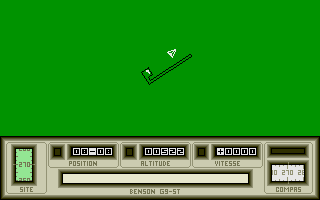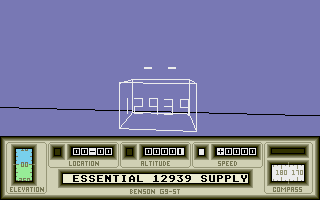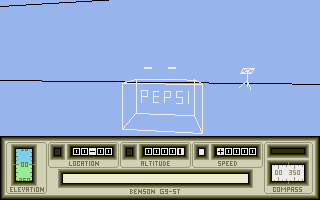MERCENARY 1 pictures (and story)
Mercenary 1 (Escape From Targ and the data set The Second City) has been released for Atari XL/XE,
Commodore 64/Plus4, Amstrad CPC, Spectrum, Atari ST and Amiga, between 1985 and 1988.
First known sightings of Mercenary begun in 1984, described as a demo of a basic flight simulator above a city, made by Paul Woakes, with the idea of later allowing landing and walking around. Paul was demonstrating it for advice, in Birmingham's shops or the BUG computer club. To turn it into a game, he got helped by Bruce Jordan who designed objects and rooms. Gary Walton, from the BUG club, designed most of the city buildings. Peter Pachla designed a loading screen. As for many games, there are probably many other inputs, which seem to have been credited with buildings names (see below). The first press previews describe a game where the player has to leave his colony craft to get some supplies from the planet. So it seems the 'escape story' was added later. Flying the ship required fuel, items were supposed to be randomly dipatched for each new game, and ground fire was considered. It seems those ideas were dropped when Bruce convinced Paul that the game had to be released. Release dates differ according to computers, countries, and physical support (disk or tape). So the following dates are approximative, based on Bruce Jordan's details and magazines reviews. The 8-bit Atari versions were released in November 1985, following a 18 months development. Then came the C64 in March 86, and the Commodore Plus 4 in July. David Aubrey-Jones was asked to convert the game to Z80 based Amstrad CPC and Spectrum (respectively released around June and September 1987). A BBC/Electron version was planned but never saw the light of day. Around July 1986, the Targ Survival Kit was realeased, a package holding a Mercenary badge, a Central City poster, underground maps and ships characteristics, and a novella written by Bruce, called Interlude On Targ (filled with hints). The 2nd City expansion set followed, for Atari and Commodore 8-bits computers in September 1986. Basically the same game, as it was based on a savegame (holding the whole world state) but with new and much more complicated mazes and plots, supposed to be the ultimate challenge for hardcore players. According to Bruce, it was created in one month time. The 16-bits computers release of Mercenary immediately included The 2nd City and the Targ Survival Kit. The Atari ST version was released in December 1986, and the Amiga version much later in April 1988. It seems that the game was not really programmed for the Amiga, but that Paul wrote a sort of Atari ST emulator to have the ST version running on it! Funnily, some later 16-bits versions re-realases did not include the 2nd City. As a small company, Novagen could not afford waiting for all versions to be complete to release the game. As a result, at some point in 1986, versions of Mercenary, the 2nd City, Damocles and possibly Backlash were being simultaneously in the works. Which could explain some of the Damocles 'delay'! The Mercenary reception was excellent on 8-bits computers, helping with Novagen and Paul Woakes's fame, after Encounter which had already been successful. David Aubrey-Jones' versions also earned excellent reviews. The 16-bits versions reception was positive, though the wireframe graphics were sometimes found to be dated, especially with the late Amiga release. More Unlike its followers, Mercenary was translated on screen, in French ("Evasion de Targ" and "La Seconde Cité") and German ("Die Flucht von Targ" and "Die Zweite Stadt"). I can't speak for the German one, but the French translation was rather poor. When asked about it, Bruce Jordan replied: "translations were done at the time by a 'commercial' bureau (?) and I can imagine how wierd is that.". The blue maps of the Targ Survival Kit were translated, too (but not the Central City poster). Side note: the MDDClone uses new and hopfeully better on-screen translations, made by long-time fan players. Did you know? Rarely seen items were produced, such as t-shirts for magazines contests, or few unfinished tape versions of Mercenary that were sold, allowing the buyer to ask for the final version later. The Suvival Kit was released to balance Paul's initial decision to have very limited clues on what to do in the game, and let the players discover by themselves. Many locations are named after Birmigham's places (Coach and Horses pub!), or contributors to the game making (from Novagen or not): Tim Bosher, Bruce Jordan, Martin Stallard, Gary Walton, Jack Moorby, ... With an exception, the Novabil monument (see Paul Hughes interview). More names can be found in the Central City map from the Targ Survival Kit, for instance journalists that wrote Mercenary previews, helping making it a hit. Speaking of names, who's hiding behind the Palyar's Commander, and his mistreated brother-in-law? Bruce answers: "Now you mention it, the Palyar Commander's brother in law is a theme still with us today. It was moi who nominated Paul as the Palyar Commander - who was the 'Good Guy' in the Mercenary story - and Paul has many 'good guy' characteristics. (I even remember the origins of Palyar - trying to imagine a 'friendly' name, I reduced it from "pal of yours"). Returning to the question, Paul was very much not in favour of his own newly aquired brother-in-law. So the 'villain' of the piece became PC BIL. Interestingly, that brother in law didn't last long before being replaced by a new one - a far nicer chap, who inspired the design of our Lighting Reality program." And where does this stange "Pipnet Elevator" name come from? Bruce again: "As for the pipnet - I wish I had a clever reason, but 'fraid not. I just made up the word, which - for some strange and inexplicable reason I just (then and now) liked the sound of." Not forgetting the (now) well known disguised Casper Hanley Eagle 8 Special Edition, shortened as CHEESE in the game, which is actually a craft, and (incidentally?) 'Kraft' being a cheese brand. |































